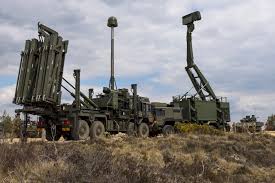Britain looking at options for air defence to defend UK

London: The Ministry of Defence (MOD) is currently evaluating the effectiveness of the nation’s air defence systems, specifically their capacity to protect critical infrastructure.
This information was provided by Luke Pollard, the Parliamentary Under-Secretary of State for Defence, in response to a question from Andrew Rosindell, Conservative MP for Romford.
Rosindell asked about the recent assessments of the UK’s air defence systems.
Pollard outlined the MOD’s ongoing review, stating, “The Ministry of Defence (MOD) is reviewing its air defence capabilities and contribution to wider national defence as part of the Strategic Defence Review (SDR) and is in close collaboration with other Government Departments to help develop the future proposition.”
Pollard highlighted the range of existing capabilities the UK employs to counter air and missile threats. “The UK currently has a wide range of capabilities to counter the Air and Missile threat facing us. This includes but is not limited to: Typhoon aircraft on Quick Reaction Alert readiness, Type 45 destroyers, short and medium range ground-based air defence, and numerous critical supporting elements.”
He further mentioned the MOD’s commitment to continuous improvement, noting, “The MOD constantly reviews its policies and capabilities in line with developing threats. The air and missile threat is proliferating and Defence will ensure that this changing threat picture is factored into the SDR work.”
The MOD recently announced a comprehensive framework for missile defence research and development, titled Science and Technology Oriented Research and Development in Missile Defence (STORM).
The contract will manage the delivery of research covering all activities to counter ballistic missiles and advanced threats, including but not limited to simple non-separating threats, complex separating threats, Manoeuvring Re-Entry Vehicles (MaRVs), Multiple Independently Targetable Re-Entry Vehicles (MIRVs), Hypersonic Glide Vehicles (HGVs), Hypersonic Cruise Missiles (HCM), and hybrid threats.
The research required will cover analysis, experimentation, trials, and technology/system development across all pillars of missile defence:
Counter-proliferation: Measures to minimise the spread of missile technology.
Deterrence: Measures to discourage the use of missile threats.
Counterforce: Actions to reduce the quantity of missiles and supporting equipment available to an aggressor during a conflict.
Active defence: Strategies to detect, track, intercept, and disable or destroy missiles in flight.
Passive defence: Measures to mitigate and recover from the effects of missile impacts.
The STORM framework, with an estimated budget of £110 million to £251 million, addresses a broad spectrum of missile defence activities. According to the MoD, the contract will “manage delivery of research covering all activities to counter ballistic missiles and advanced threats including but not limited to simple non-separating threats, complex separating threats, Manoeuvring Re-Entry Vehicles (MaRVs) and Multiple Independently Targetable Re-Entry Vehicles (MIRVs), Hypersonic Glide Vehicles (HGVs), Hypersonic Cruise Missiles (HCM) and hybrid threats which share characteristics with BM, HGV and/or HCM.”
The MoD outlines the historical and ongoing challenges posed by ballistic missiles: “Since the first V2 attack on London in 1944, ballistic missiles have posed a near constant threat to the UK, its overseas interests, and forces. Adversaries continue to invest in and proliferate increasingly advanced ballistic and manoeuvrable threat systems to challenge our freedom of action.”
The MoD specifies the pillars of missile defence research under the STORM framework as follows:
“Counter-Proliferation: Measures to minimise the spread of missile technology.”
“Deterrence: Measures to discourage the use of missile threats.”
“Counterforce: Actions to reduce the quantity of missiles and supporting equipment available to an aggressor during a conflict.”
“Active Defence: Strategies to detect, track, intercept, and disable or destroy missiles in flight.”
“Passive Defence: Measures to mitigate and recover from the effects of missile impacts.”
The UK Missile Defence Centre (MDC), a unique government-industry partnership within the MoD Head Office, will spearhead the STORM framework. The MDC is responsible for all UK missile defence Research & Development (R&D) and provides support to decision-makers on all aspects of missile defence. The MDC was established to “provide a pipeline of funding to sustain SQEP (Suitably Qualified and Experienced Personnel) in relevant UK industry sectors.”
The MoD highlights the strategic importance of the STORM framework: “The Missile Defence R&D Category Strategy, approved in May 2023, recommended creation of a new route to market bringing together core research and technology maturation projects into a single contract, enhancing research outcomes and supply chain efficiency.”
The selected contractor will work closely with the MDC to “design and manage a contract pipeline to deliver the Missile Defence R&D category’s research requirements.” This includes large, multi-year research technology maturation projects, multinational and multi-supplier trials, and short-term rapid analysis. The coordination function is envisaged to be co-located with the Missile Defence Centre in Farnborough.
The notice further details that “the research required will cover analysis, experimentation, trials and technology/system development across all pillars of missile defence.”
The STORM framework is part of the 2020 MOD Science & Technology (S&T) Strategy, which aims to “sustain, exploit, and develop UK industrial and academic expertise to continue to develop next-generation and generation-after-next technologies applicable to Integrated Air and Missile Defence.”





